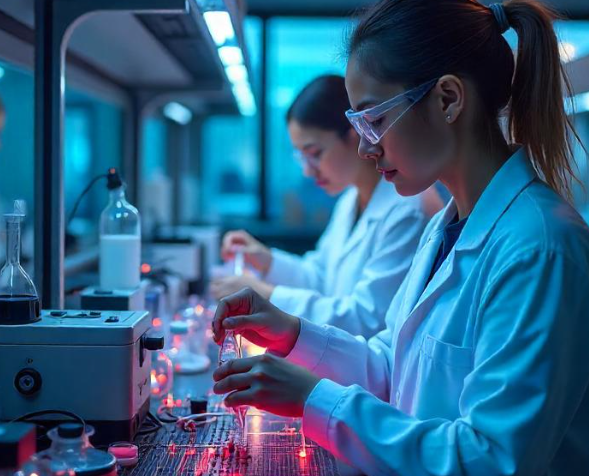Decoding Muscle Disease Triggers: New Research Reveals Titin's Role, Paving Way for Therapies
(Source: Centro Nacional de Investigaciones Cardiovasculares Carlos III (F.S.P)
Introduction: Peering into the Mechanical Heart of Muscle Dysfunction
Muscular diseases, encompassing debilitating conditions like muscular dystrophies and various cardiomyopathies, often trace their origins to genetic flaws impacting crucial proteins. Central to muscle function is titin, an enormous protein that acts as the foundational scaffold of muscle cells. While titin's role in these diseases has been long recognized, the precise mechanics by which its disruption leads to pathology have remained challenging to dissect. Now, a pioneering team at the Centro Nacional de Investigaciones Cardiovasculares (CNIC), under the leadership of Jorge Alegre-Cebollada, has engineered a groundbreaking method, termed TEVs-TTN, which provides an unprecedented window into how the mechanical integrity of titin, when compromised, directly precipitates muscular diseases. This innovation not only deepens our fundamental comprehension of these conditions but also illuminates promising new pathways for the development of targeted therapies.
Titin: The Colossus of Muscle Structure and Function
Befitting its name, derived from the powerful Titans of Greek mythology, titin is not only the largest known protein found in animals but also an indispensable structural component within sarcomeres. These microscopic units are the fundamental contractile engines of muscle cells, responsible for generating the force that enables movement. Titin’s immense size and strategic positioning within the sarcomere allow it to function as a molecular spring, imparting elasticity to muscles, facilitating the transmission of mechanical force, and ensuring the structural stability of the sarcomere itself.
Genetic mutations within the TTN gene, which provides the blueprint for titin, are a leading cause of various inherited muscular diseases and cardiomyopathies (diseases affecting the heart muscle). As elaborated by the study's first author, Dr. Roberto Silva-Rojas, "Many of these mutations generate a prematurely truncated form of the protein, impeding its correct anchoring in the sarcomeres and disrupting muscle function." This truncation results in a dysfunctional titin, directly undermining the intricate architectural framework essential for proper muscle contraction.
Introducing TEVs-TTN: A Precision Tool to Mimic and Study Disease Pathology
Until recently, the precise mechanical consequences of titin's disruption specifically, how these truncated forms of the protein lead to the development of disease have been notoriously difficult to investigate due to the absence of appropriate experimental models. The CNIC team's ingenious TEVs-TTN methodology represents a significant leap forward in addressing this critical research void. This innovative technique enables the controlled cleavage, or targeted cutting, of proteins in a highly precise manner that renders them specifically unable to sense and transmit mechanical force.
By applying this cutting-edge TEVs-TTN approach to titin, the researchers successfully replicated the characteristic sarcomere disorganization typically observed in patients suffering from TTN mutations. Dr. Silva-Rojas underscored the striking fidelity of this replication: "Muscles with cleaved titin show similar defects to those observed in patients, including cell-volume reduction, nuclear internalization, mitochondrial aggregation, and interstitial fibrosis." The meticulous reproduction of these complex pathological features within the laboratory setting powerfully validates TEVs-TTN as an exceptionally valuable tool for modeling and studying disease.
"In the absence of experimental animal models with titin-cleavage mutations," Dr. Silva-Rojas highlighted, "our approach allows a structured and targeted analysis of the impact of these types of alterations. This makes TEVs-TTN an ideal tool for testing therapies designed to mitigate the effects of impaired sarcomere integrity." This capability is paramount for accelerating the drug discovery process for these challenging diseases.
Profound Consequences of Titin Disruption: Sarcomere Collapse and Cellular Resilience
One of the most compelling and, perhaps, unexpected discoveries emerging from this study was the dramatic consequence of titin cleavage: it led to the complete disintegration of sarcomeres within a mere few days. This left the affected muscle cells entirely devoid of their fundamental functional units.
Remarkably, despite this catastrophic structural breakdown, the muscle cells demonstrated an impressive capacity for survival. This intriguing observation prompts fascinating questions and suggests that similar cellular resilience mechanisms might be at play in other severe muscle-related pathological conditions, such as:
· Acute muscle tears: Where sudden, traumatic damage leads to significant structural disruption.
· Heart failure: A complex condition often characterized by severe impairment of cardiac muscle function and extensive cellular remodeling.
· Cardiotoxicity associated with chemotherapy: Specific cancer treatments can induce damage to heart muscle, leading to impaired function.
A deeper understanding of how cells can persist even after such profound structural loss could pave the way for novel strategies aimed at preserving tissue viability and function across a diverse range of diseases.
Broader Implications: Transforming the Landscape of Protein Mechanics Research
The methodology meticulously developed at the CNIC represents a monumental achievement, with implications that stretch far beyond the isolated study of titin. It signifies a pivotal advancement in our collective capacity to investigate the intricate ways in which the mechanics of individual proteins contribute to the overall physiological function of various tissues and organs throughout the body.
While titin’s critical role in transmitting force within sarcomeres serves as a compelling example of mechanical importance, numerous other proteins also exert vital mechanical functions. These include:
· Dystrophin: A protein whose absence or dysfunction directly causes Duchenne muscular dystrophy, a severe muscle-wasting disease.
· Dystroglycan complexes: Intricate protein assemblies crucial for linking the muscle cytoskeleton to the surrounding extracellular matrix, maintaining structural integrity.
· Integrins: A family of cell surface receptors that play multifaceted roles in mediating cell-matrix adhesion, cell-cell interactions, and critical intracellular signaling pathways.
· Lamins: Intermediate filament proteins that form the nuclear lamina, a fibrous network crucial for maintaining the structural integrity of the cell's nucleus and regulating various nuclear processes.
The newly developed TEVs-TTN tool provides researchers with an unprecedented capability to precisely confirm or refute long-standing hypotheses regarding the mechanical functioning of these, and indeed many other, vital proteins. These scientific advancements, in turn, hold immense promise for accelerating the discovery and development of novel therapeutic strategies, not exclusively for diseases affecting muscle but for a broad spectrum of conditions impacting various organs and tissues where protein mechanics are recognized as critically important.
Labels: Decoding Muscle Disease Triggers: New Research Reveals Titin's Role, Paving Way for Therapies






0 Comments:
Post a Comment
If you have any doubt, please let me know
Subscribe to Post Comments [Atom]
<< Home